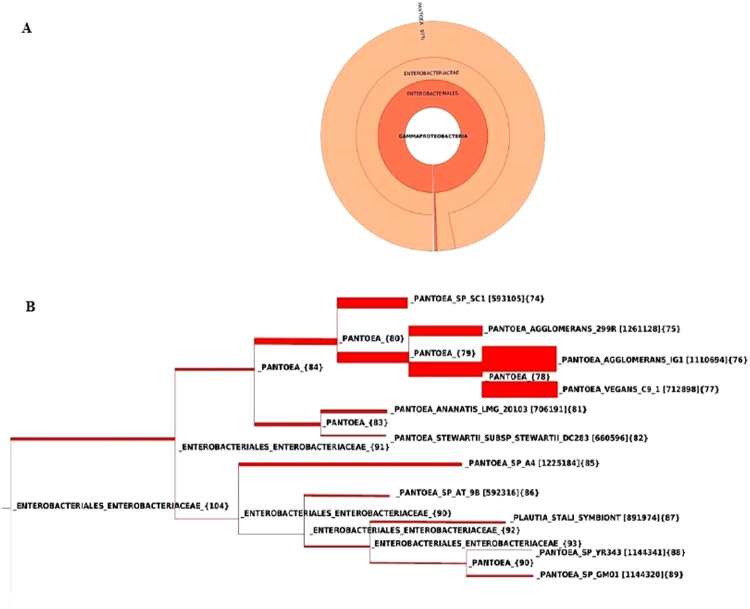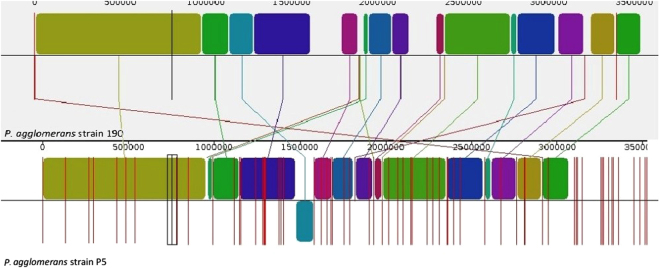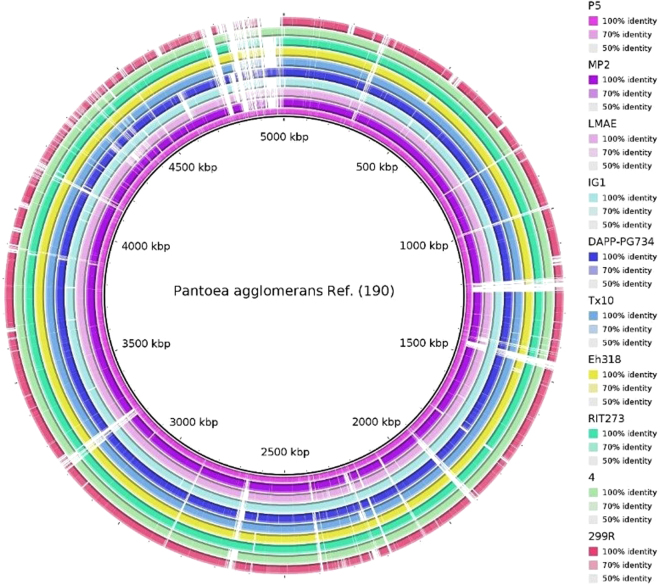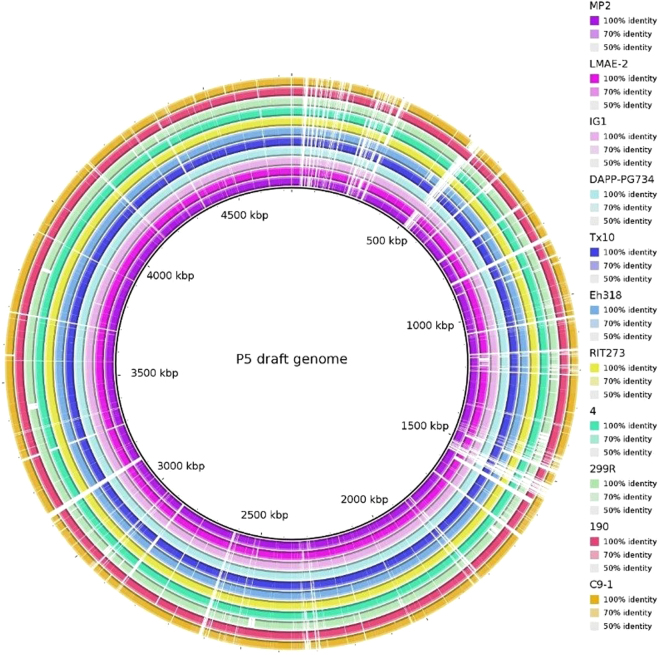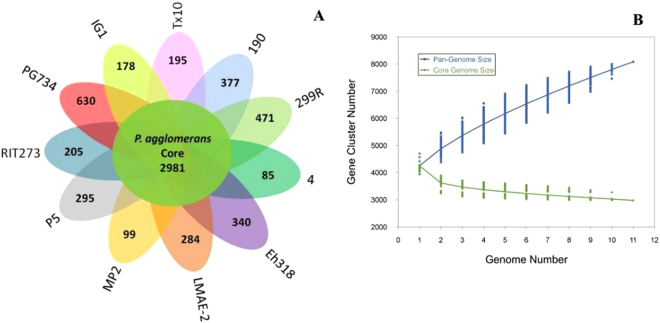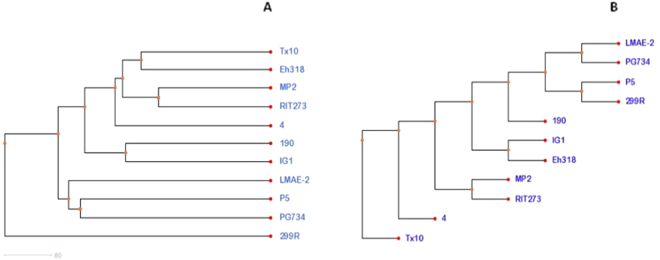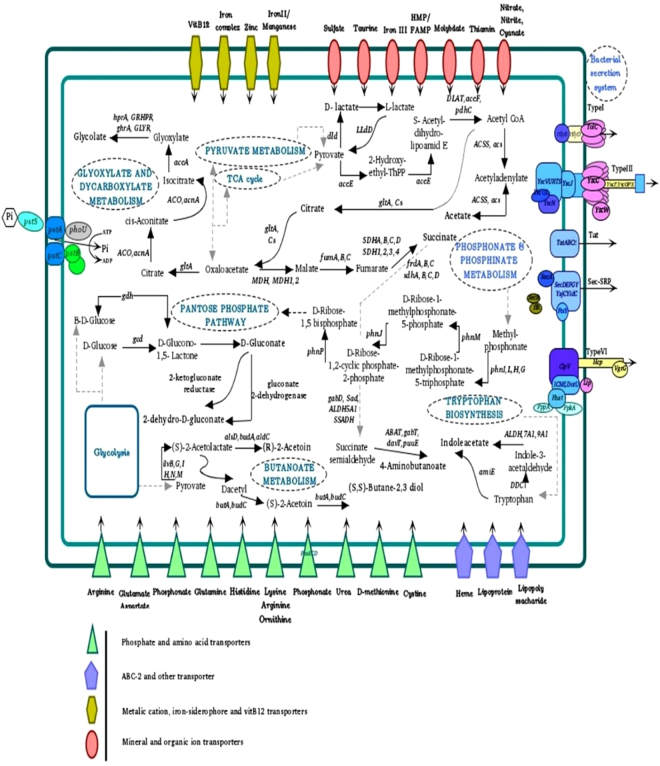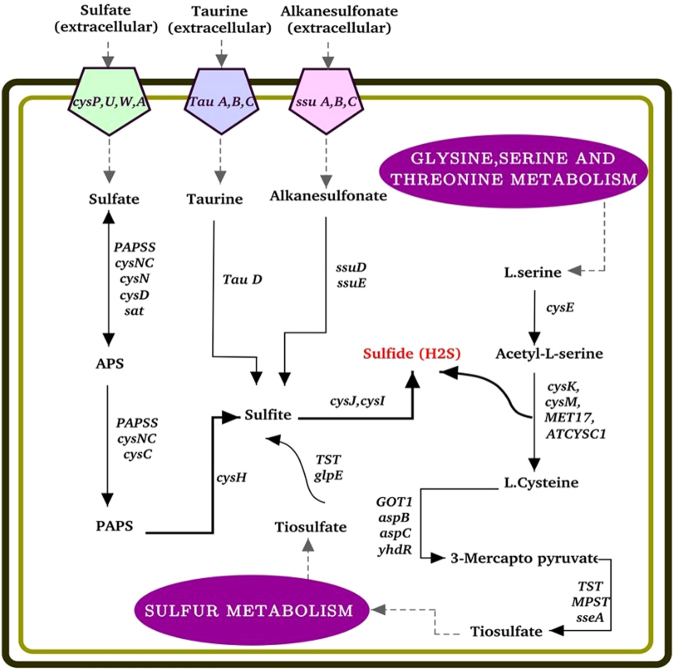Abstract
In this study, we provide a comparative genomic analysis of Pantoea agglomerans strain P5 and 10 closely related strains based on phylogenetic analyses. A next-generation shotgun strategy was implemented using the Illumina HiSeq 2500 technology followed by core- and pan-genome analysis. The genome of P. agglomerans strain P5 contains an assembly size of 5082485 bp with 55.4% G + C content. P. agglomerans consists of 2981 core and 3159 accessory genes for Coding DNA Sequences (CDSs) based on the pan-genome analysis. Strain P5 can be grouped closely with strains PG734 and 299 R using pan and core genes, respectively. All the predicted and annotated gene sequences were allocated to KEGG pathways. Accordingly, genes involved in plant growth-promoting (PGP) ability, including phosphate solubilization, IAA and siderophore production, acetoin and 2,3-butanediol synthesis and bacterial secretion, were assigned. This study provides an in-depth view of the PGP characteristics of strain P5, highlighting its potential use in agriculture as a biofertilizer.
Subject terms: Comparative genomics, Prokaryote
Introduction
The mechanisms and molecular basis of plant growth promoting traits such as phosphate solubilization differ among bacterial species1. Phosphate-solubilizing bacteria applied as bio fertilizers assist in the hydrolysis of an extensive range of P compounds that lead to increased growth and yield in plants2–4.
The genus Pantoea includes several species that are isolated from water, soil, humans, animals and plants as pathogens, symbionts or commensals5,6. Distinctive strains of Pantoea agglomerans are recognized as plant growth-promoting rhizobacteria (PGPR) and used in the form of soil inoculants as biofertilizers in agriculture. As shown by Malboobi et al., the P. agglomerans strain P5 is one of the important strains that hydrolyze inorganic and organic phosphate compounds effectively7 by the conversion of insoluble forms of phosphate into soluble forms through the secretion of organic acids or protons8. It is a Gram-negative bacterium that is commercially produced as a phosphate biofertilizer named PhosphoBarvar-2.
Whole-genome shotgun (WGS) sequencing and annotation analysis of the whole-genome data can lead to the identification of genes that are conducive to the beneficial activity of PGPR.
This analysis will provide insight into the molecular mechanisms, functional capabilities and biodiversity of this bacterial species. Therefore, WGS has been recently employed to study the genomes of several PGPRs such as a Klebsiella strain9, a Pseudomonas strain10, a Bacillus strain11, Paenibacillus polymyxa10, Enterobacter, Erwinia, Serratia, Alcaligenes, Arthrobacter, Acinetobacter and Flavobacterium8,12. In this study, whole-genome sequencing and annotation of P. agglomerans strain P5 was performed and compared with the 10 most similar strains through Pan-genome and phylogenetic analyses to determine strain propinquity and to identify target genes and mechanisms that contribute to the beneficial interaction between bacteria and plants that eventually results in plant growth promotion and the improvement of soil fertility13. Because of insufficient knowledge regarding to plant growth-promoting function in P5 strain, our comparative genomic study will present a global view of its possible genetic basis.
Results
Statistics of P. agglomerans strain P5 sequences
Next-generation shotgun sequencing using the Illumina HiSeq 2500 platform resulted in approximately 180-fold coverage of the P. agglomerans strain P5 genome. In total, 10,396,856 raw reads 90 bp in length were subjected to filtering for reads with > 10% Ns and/or 25–35 bases with a low quality average (≤Q20). Finally, 9.919 million clean reads were used for downstream analysis (Tables S1 and S2). De novo assembly optimization of the reads resulted in 150 scaffold with total length of 5,082,485 bp using k-mer 21, 33, 55, 73, 89. As a result of final assembly the set of scaffolds (≥500 bp) was defined, consisting of 110 scaffolds with lengths ranging from 902 bp to 280,881 bp (N50 = 112,468 bp), resulting in a total length of 5,070,221 bp (Table S3).
P. agglomerans strain P5 genome features and comparative genome analysis
The genome of P. agglomerans strain P5 has a single circular chromosome of ~5 Mbp with a genomic GC content of 55.4%. A total of 4745 genes were predicted in this genome, encoding 4674 putative coding sequences (CDS). Furthermore, a total of 63 tRNA-coding genes and 7 rRNA genes were predicted in the chromosome sequence. PhyloSift analysis was conducted to reveal phylogenetic models providing high resolution identification of organisms (Fig. 1). Then, to find the best reference sequenced genome, the strain P5 reads were mapped against each of the 10 available relevant genome sequences. Ultimately, P. agglomerans strain 190 was selected as an appropriate reference genome (Table S1). Using the Gepard dot plot software and progressive Mauve from the Mauve software, we compared the ordered genome assembly of strain P5 with that of strain 190 (GenBank: GCA_000731125.1) as a reference genome. The genome alignment indicated the presence of 20 collinear blocks (Fig. 2), with several regions of inversion and rearrangement. It seems that the chromosomal alignments of these strains are approximately identical, as shown by the existence of large segments of high similarity when most portions of the two chromosomes are mapped onto each other. On the other hand, a region between contigs 4 to 6 in the P5 chromosomal scaffold approximately at 2 Mb of the P5 chromosome displays inversion, revealing different syntenial relationships to the reference sequence.
Figure 1.
Taxonomic assignment of P. agglomerans strain P5. The tree was inferred using FastTree from an Hmmalign alignment of P5 reads to 37 concatenated universal single-copy marker genes in Phylosift. The closely related genomes are shown by the red indicator with their GenBank accession numbers provided in parentheses. Here, tree was rooted to P. agglomerans as the closest species.
Figure 2.
Genome alignment showing syntenic blocks between P. agglomerans strains 190 (top) and P5 genomes (bottom).
Additional genomic features of P. agglomerans strain P5 and 10 closely related genomes, such as the sequence similarity, distribution of GC content and the number of genes including tRNA and rRNA, were analyzed (Figs 3 and 4, Table 1). The genome size, total number of genes and total predicted CDS of P5 are similar to but slightly smaller than those of RIT273 and DAPP-PG734, while DAPP-PG734 appears to have a larger genome size of ~5.3 Mb.
Figure 3.
Genome comparisons of P5 strain and other P. agglomerans strains against reference genome (strain 190) generating by BRIG 0.95, the circular map illustrates the whole genome comparison of strain 190 against the other 10 sequenced P. agglomerans. The inner cycle (back) represents the complete genome of the reference strain 190 and the shade of each colors show the similarities between each strains with strain 190.
Figure 4.
Genome comparisons of other P. agglomerans strains against drafted P5 genome. The inner cycle (back) represents the complete genome of the reference strain P5 and the shade of each colors show the similarities between each strains with strain P5.
Table 1.
The genomes of Pantoea agglomerans strains used for mapping and comparative genome analysis.
| Strains | Genome size (Mb) | GC% | No. of rRNA | No. of tRNA | Scaffolds | No. of Genes | No. of Proteins | GenBank Accession no. |
|---|---|---|---|---|---|---|---|---|
| P5 | 5.16726 | 55.4 | 7 | 63 | 150 | 4745 | 4674 | GCA_002157425.2 |
| Tx10 | 4.85699 | 55.1 | 48 | 142 | 22 | 4627 | 4500 | GCA_000475055.1 |
| Eh318 | 5.03584 | 54.8 | 28 | 73 | 34 | 4791 | 4627 | GCA_000687245.1 |
| 190 | 5.00257 | 55.1 | 24 | 77 | 5 | 4878 | 4778 | GCA_000731125.1 |
| MP2 | 4.73383 | 55.2 | 22 | 71 | 16 | 4352 | 4214 | GCA_000757415.1 |
| IG1 | 4.82958 | 55 | 2 | 63 | 18 | 4443 | 4341 | GCA_000241285.2 |
| 299 R | 4.58148 | 54.3 | 27 | 63 | 109 | 4267 | 4157 | GCA_000330765.1 |
| RIT273 | 5.36534 | 55.1 | 17 | 76 | 26 | 4999 | 4914 | GCA_000627115.1 |
| DAPP-PG734 | 5.36593 | 54.7 | 36 | 70 | 195 | 5107 | 4937 | GCA_000710215.1 |
| 4 | 4.8102 | 55.1 | 19 | 72 | 12 | 4370 | 4260 | GCA_000743785.1 |
| LMAE-2 | 4.98116 | 55.1 | 51 | 79 | 155 | 4681 | 4406 | GCA_000814075.1 |
P. agglomerans pan-genome features
A pan-genome for the strain P5 and ten sequenced P. agglomerans strains was determined by PGAP, comparing of the translated CDS set, followed by clustering of orthologous proteins and the representatives of each orthologous cluster and strain-specific CDS in the total pan-genome. The total pan-genome for the 11 compared P. agglomerans strains encompasses 6140 CDS. Of these, 2981 (48.5% of total CDS) are core conserved genes across all 11 strain genomes compared. A total of 3159 protein CDS (51.44% of the pan-genome total) constitute the accessory fraction, which are unique to each genome. The smallest numbers of specific genes were encoded by P. agglomerans strains 4 and MP2, with 85 and 99, respectively.
The highest numbers of specific genes belong to P. agglomerans strains PG734 and 299 R, with 630 and 471, respectively (Fig. 5). The number of unique CDS in the target genome strain P5 was 295 CDS. Several virulence genes have been identified in Gram-negative bacteria, including those related to hypersensitive responses and pathogenicity (hrp), effectors of avirulence (avr) and bacterial toxins, among others. It is well known that the type III secretion system, governed by the hrp/hrc gene cluster, promotes bacterial pathogenesis by the secretion of effector proteins directly into the host cell. Hence, to identify the bacterial virulence genes (hrp/hrc gene cluster) that may eventually lead to plant disease promotion, we evaluated the set of clusters of orthologous genes shared by P. agglomerans strain P5 and its 10 closest strains. After studying the core genome and pan-genome, we found the complete hrc/hrp gene cluster only in strain PG734, whereas we found some hrp/hrc genes in the strain P5, 190 and IG1 genomes (Table S4).
Figure 5.
Plot of core/pan-genome and Venn diagram for the core genome and strain- specific CDS of the P. agglomerans strains. (A) The number of unique CDS for each strain of the P. agglomerans pan-genome. (B) Comparisons of n = 1 → 11 genomes to determine the core genome and strain-unique CDS for the eleven sequenced P. agglomerans strains.
As reported in various studies, a bacterial adaptive immune system called the CRISPR-Cas system is acquired by some bacterial species. It has been utilized to improve genome editing technology, ultimately leading to improved viral defense systems. The P5 genome includes genes related to type I CRISPR-Cas systems (Table S5), indicating the presence of a microbial defense system against intrusive elements14. Moreover, Pan-genome analysis identified 295 strain specific genes for P5 consisting 55 known genes belonging to phosphotransferase system (PTS), transcription regulators, ABC transporter, transferases and etc. (Table S5).
Intra-species phylogenetic tree analysis
The phylogenetic relations of P. agglomerans strain P5 and 10 other P. agglomerans strains were demonstrated separately based on the pan-genome and the core genome. As shown in (Fig. 6), analysis based on the pan-genome clustered P. agglomerans strains P5 and PG734 in the same clade, genetically close to the LMAE-2 genome. This analysis also showed a distant phylogenetic relationship between strain 299 R and the others, whereas 299 R was clustered in the same clade as strain P5 in phylogenetic analysis based on the core genomes. Moreover, strain PG734 and strain LMAE-2 were clustered together and close to strain P5.
Figure 6.
Phylogeny of the P. agglomerans strains based on the analysis of pan-genomes (A) and Single Nucleotide Variants (SNVs) in core genomes (B).
Genes related to plant growth promotion
The annotation of the P. agglomerans strain P5 genome identified genes associated with the solubilization of phosphate, indole acetic acid (IAA), siderophores and phytohormone productions that are conducive to plant growth promotion9,15,16 It is well known that a large portion of inorganic phosphates become immobilized after application as fertilizer, resulting in the inaccessibility of the phosphate to plants13. Therefore, the capability of some bacterial species to solubilize insoluble or insufficiently soluble mineral phosphates by generating acid phosphatases and organic acids, especially gluconic acid, is important17.
Organic acid production and phosphate metabolism
Gluconic acid (GA) is an organic acid that is significantly responsible for the solubilization of mineral phosphates. GA biosynthesis is carried out by glucose-1-dehydrogenase (gcd) along with its co-factor pyrrolo-quinolone quinine (PQQ). In addition, gluconic acid dehydrogenase (gad) contributes to GA production and its conversion to 2-ketogluconate18,19. Accordingly, P5 genome annotation indicated the possession of several genes related to gluconic acid biosynthesis and its co-factor genes, including pqqBDEF19. Another organic acid identified in the P5 strain that is relevant to the phosphate-solubilizing trait is 2-ketogluconic acid, which is produced by gluconate 2-dehydrogenase alpha/beta chain and 2-keto-D-gluconate reductase. Moreover, the P5 strain of P. agglomerans was found to produce other organic acids such as lactic, acetic, glycolic, succinate, and citric acid (Table S6).
Various studies have indicated that another rich source of soil P is in the form of phosphonate. Phosphonate is an organophosphorus compound that contains a direct carbon-phosphorus (C-P) bond in place of the better known linkage of phosphate esters (C-O-P)20. The phosphonate-related phn gene cluster is responsible for the release of biologically available phosphate through the bacterial degradation of phosphonates. Our comparative genomic study revealed that strain P5 carries several phn genes, including phnHNIKJGAPBLOEF, showing the capability of hydrolyzing phosphonate into phosphate and an alkane. Furthermore, the P5 genome encodes phnA, which is required for the degradation of phosphonoacetate. These require the route of phosphorus-compound transport across the plasma membrane before utilization. P5 fulfills this task through two high-affinity phosphate transport systems, PstBACS (phosphate transporter) and PhnE2E1DC (phosphonate transporter) (Table S7). The P5 strain does not carry the necessary genes (ppd, pepM) for 2-amino-ethylphosphonate and phosphonopyruvate degradation. In addition, it does not carry phnW, which is needed for the biosynthesis of phosphonates (Fig. 7).
Figure 7.
Schematic overview of metabolic pathways of P. agglomerans strain P5. The portrayed pathways were identified based on the genomic data, which show the strain carries genes consistent with the ability to solubilize phosphate compounds. The genome also includes a complete carbohydrate metabolic pathway involving glycolysis/gluconeogenesis, the tricarboxylic acid (TCA) cycle, pyruvate metabolism and the pentose phosphate pathway (PPP). The latter includes the genes responsible for gluconic acid synthesis from D-glucose, such as gcd and gdh and the related pathways. Similarly, the synthesis of other organic acids is shown in their specified pathway.
Sulfate assimilation
Hydrogen sulfide (H2S) has emerged as an important molecule with beneficial effects on phosphate solubilization. H2S reacts with ferric phosphate to yield ferrous sulfate and the liberation of phosphate. The sulfur metabolism in strain P5 includes the mineralization of organic sulfonates and taurine or 2-aminoethanesulfonic acid towards the assimilation of inorganic sulfate. The strain P5 genome encodes the set of genes that are responsible for H2S biosynthesis (Table S8, Fig. 8), including the cysCIJHND, PAPSS, and sat genes involved in assimilated sulfate reduction. Thiosulfate is converted to sulfide by the products of the TST and glpE genes and to homocysteine by cystathionine gamma-synthase (metB) enzymes. Furthermore, the strain P5 genome contains the ssuD and ssuE genes, which are related to the conversion of alkanesulfonate to sulfite, and the tauD gene for taurine. On the other hand, the P5 genome also possesses taurine transporter-related proteins including tauA, tauC, and tauB, a sulfonate transport system including ssuA, ssuB, and ssuC and a sulfate transport system including cysPUWA (Table S9). In addition, a transcriptional regulator coding gene, cysB, that is considered to be the main regulator for sulfur assimilation was identified in the P5 genome.
Figure 8.
Schematic summary of hydrogen sulfide (H2S) production pathways. The figure illustrates the integration of metabolic pathways contributing to the production of sulfite. The metabolism of sulfur in P5 includes the assimilation of inorganic sulfate and the mineralization of organic taurine and sulfonates. The ABC-type transportation system includes a periplasmic binding protein as well as cysPUWA for sulfate, TauABC for taurine and ssuABC for alkanesulfonate transportation. Inorganic sulfite is a common point among four pathways, including 1) sulfate-APS-PAPS, 2) L-cysteine-3-mercaptopyruvate-thiosulfate-sulfite, 3) taurine-sulfite, and 4) alkanesulfonate-sulfite. Sulfite is then reduced to sulfide by cysIJ.
Secretion systems
A highly specialized secretion system has developed in bacterial species. The bacterial secretion system plays an important role not only in the response of a bacterium to its environment but also in several physiological processes. We found three potential outer-membrane protein secretion systems, including Types I, III, and VI, as well as two other secretion systems, Tat (twin arginine translocation) and Sec-SRP (general secretory pathway), in the P5 genome (Table S10, Fig. 7).
Plant growth promotion hormones and volatile compounds
The production and/or activation of phytohormones such as auxin and cytokines or other factors that modulate plant regulatory systems are employed by PGPR to enhance plant growth through the regulation of cellular activities, pattern formation, vegetative and reproductive development and stress resistance21,22.
Indole-3-acetic acid (IAA) is the primary auxin endogenously synthesized by PGP bacteria and has an essential effect on plant growth and development processes, such as cell elongation and organogenesis, as well as tropic responses. IAA can be produced from tryptophan via four alternative pathways, including the indole-3-acetamide (IAM), indole-3-pyruvic acid (IPA), tryptamine (TAM) and indole-3-acetaldoxime (IAOX) pathways23. Here, P5 carries the amidase gene, which contributes to the indole-3-acetamide conversion to IAA in the IAM pathway. Some genes responsible for IAA biosynthesis, such as ipdC, are absent in the P5 genome. These results indicate that the IAM pathway may be the sole route for IAA production in this strain24.
Volatile organic compounds (VOCs) including 3-hydroxy-2-butanone (acetoin) and 2,3-butanediol secreted by P. agglomerans strain P5 may not only promote plant growth by stimulating root formation but also play a role in increasing systemic disease resistance in plant-bacteria interactions25. In this study, several genes implicated in acetoin and 2,3-butanediol synthesis, including genes that encode enzymes such as acetolactate synthase, acetolactate decarboxylase, butanediol dehydrogenase and acetoin reductase, were detected26. Therefore, the function of these genes could be assigned to growth promotion and systemic disease resistance (Table S11, Fig. 7).
It has been reported that PGPR may produce compounds such as 4-hydroxybenzoate, which act as antibiotics and suppress plant pathogenic microbes, or γ-aminobutyric acid (GABA), which is responsible for pest and disease inhibition. We identified UbiC, which is involved in 4-hydroxybenzoate synthesis, and the gabD and gabT genes, which contribute to GABA synthesis, in the genome of strain P5 (Table S11).
Siderophore biogenesis
It has been shown that siderophores, high-affinity iron-chelating compounds, are largely produced by bacterial strains associated with plants27 and can benefit them by retrieving iron from the environment21. Our genomic study showed that P5 is able to synthesize an enterobactin siderophore involving the EntD, EntF, EntC, EntE, EntB and EntA genes. The siderophore is then exported from the cell using entS and is responsible for recovering iron by complex formation. Having siderophore receptors, bacteria may heterologously adopt siderophores produced by other organisms as well. P. agglomerans strain P5 encodes several genes for siderophore receptors, including TonB-dependent outer-membrane receptors and three putative ferric enterobactin receptors (fepA) (Table S12).
Discussion
In this study, we sequenced, analyzed and compared the genome of P. agglomerans strain P5, which is commercially used as a biofertilizer. The genomic data of strain P5 supported previous observations of its ability to promote plant growth by playing a primary role in solubilization of phosphate4,7. Our comparative genomic analysis of P. agglomerans strain P5 and 10 previously sequenced strains shows high propinquity between these strains, particularly strains DAPP-PG734, LMAE-2 and 190. As confirmation, a phylogenetic tree was constructed based on the pan-genome that revealed P. agglomerans strains P5 and PG734 to be in the same clade and genetically close to strain LMAE-2 (Fig. 6A). Furthermore, a phylogenetic tree based on the core genome also supports and reveals the low difference in SNV content among these strains (Fig. 6B), which indicates their evolution from a common ancestor.
In addition, our analysis of the core genomes and pan-genomes provided some clues on the specific genes involved in plant disease development and molecular basis of pathogenic capacity among the studied strains of P. agglomerans.
Many Gram-negative bacteria use type III secretion systems (T3SSs) as injection devices to convey effectors (T3Es) directly into the cytosol of infected host cells and colonize their host organisms28. T3SSs are encoded by the hrc/hrp gene cluster, which is related to hypersensitive responses (HRs) and pathogenicity in susceptible plants. Accordingly, several studies have indicated the contributions of these virulence factors, which are designated pathogenicity-related genes in plant diseases. Hence, we performed a comparison to characterize the genetic differences among all 11 close strains to reveal the genes involved in plant disease development. Here, our analysis of the core genomes and pan-genomes of the 11 strains indicates the presence of the hrc/hrp gene cluster in only four strains, namely, strains PG734, P5, IG1 and 190 (Table S4). However, the strain PG734 is the only genome containing the complete hrc/hrp gene cluster and also the only strain with pathogenic activity29.
It is noteworthy that the HR-inducing strain PG734, which is commonly isolated inside olive knots, cooperates in the creation and development of olive knot disease. As mentioned by Buonaurio (2015)29, strain PG734 is able to convey the AvrE effector superfamily, DspA/E, into olive cells. By transferring these effectors, PG734 represses the host defenses and therefore promotes the development of the microbiota inside the olive knot30,31. In addition to the role of the hrpG/hrpX genes in strain PG734, as a key global coordinator of the expression of multiple different virulence factors such as T3SS effectors or hrpB, hrpD, and hrpF, which are associated with elicitation of the plant hypersensitive response, the significant role of the complete hrc/hrp gene cluster can be explained by this observation that bacterial Avr genes are functionalized only in the presence of a complete set of hrp genes32. Consequently, without the complete T3SS, P5 is unable to elicit active basal defenses or the hypersensitive response33,34. Therefore, P5 can be considered as a safe bio fertilizer without any concern on its possible conversion into pathogen.
It is well known that the chief mechanisms of the solubilization of mineral phosphate are the release of organic acids, protons, and hydroxyl ions and the secretion of enzymes synthesized by soil microorganisms3,12. As revealed by Rodriguez et al. (2006)8, gluconic acid is the most frequent agent produced by phosphate-solubilizing bacteria such as P. agglomerans (formerly named Erwinia herbicola), Pseudomonas cepacia and Burkholderia cepacia. The analysis of the strain P5 genome revealed that it carries gcd and gad genes known to be responsible for gluconic acid and 2-keto-D-gluconic acid production, which are involved in solubilizing inorganic mineral phosphates. 2-Ketogluconic acid is also present in Rhizobium leguminosarum, Rhizobium meliloti and Bacillus firmus8,17. Gyaneshwar et al. (1999) revealed that mineral phosphate solubilization mutants of Enterobacter asburiae with deficiency in glucose dehydrogenase (GDH) activity fail to release the phosphate from alkaline soils35.
Furthermore, we identified several citrate synthase genes in the strain P5 genome that seem to increase the secretion of organic acids and hence the availability of phosphate to the plant. According to Lopez-Bucio et al. (2000), under phosphate limitation, to achieve optimal growth by the overproduction of citrate, a plant can produce more leaf and fruit biomass. This finding indicates the essential role of organic acid synthesis genes in P uptake in plants36. Similarly, genes related to the production of other organic acids including glycolic acid, lactic acid, citrate and succinate were detected, which have also been identified among phosphate solubilizers4,37.
Consequently, it could be assumed that any gene involved in organic acid synthesis might have a profound effect on this ability. Phosphate-specific transporter systems have already been reported in E. coli, B. subtilis, P. polymyxa and Klebsiella9,13,38. Here, we showed that strain P5 also carries the pst operon, including pstS, pstC, pstA and pstB. PstS is a binding protein, PstC and PstA are two integral inner membrane proteins, and PstB is an ATP-binding protein39. Therefore, strain P5 takes up inorganic phosphate partially through a phosphate transport system.
Under phosphate starvation conditions, when readily soluble forms of phosphate compounds are not present, microorganisms have evolved to utilize additional organophosphorus sources, including phosphonates. The enzymes of phosphonate catabolism are conserved in bacteria and encoded by orthologous genes. The genes for phosphonate uptake and degradation in E. coli were shown to be fourteen in number (phnCDEFGHIJKLMNOP)40. Similarly, the genomic analysis of strain P5 revealed the presence of phn genes (phnHNIKJGAPBLOEF) responsible for solubilizing organic phosphate. PhnC, PhnD and PhnE constitute a phosphonate transporter, while PhnG, PhnH, PhnI, PhnJ, PhnK and PhnL are required to degrade phosphonate into phosphate and an alkane, and PhnF and PhnO play regulatory roles20. Moreover, the strain P5 genome encodes phnA, which is required for the degradation of phosphonoacetate40. The production of H2S is the other mechanism of phosphate solubilization. H2S then reacts with ferric phosphate to yield ferrous sulfate with the concomitant release of phosphate. Here, we showed that the strain P5 genome encodes the TST, cysj, and cysI genes, which contribute to producing H2S from thiosulfate, as well as cysteine synthases that are reported to produce H2S in E. coli41.
Consistent with the PGPR properties reported in other studies9,11,13,24, we detected some genes in the strain P5 genome that are associated with IAA production, siderophore, acetoin, and 2,3-butanediol synthesis and the bacterial secretion system. As shown in Enterobacter strain 638, increased levels of phytohormones including IAA, acetoin and 2,3-butanediol stimulate root development, resulting in better access to nutrients and water, which in turn increases plant growth24. Moreover, the production of acetoin and 2, 3-butanediol by PGPR has been reported to increase systemic acquired resistance (SAR) and drought tolerance. Whereas most reports of PGPR-mediated SAR include free-living rhizobacterial strains, there are some reports indicating SAR activity in endophytic bacteria. For instance, SAR was activated by P. fluorescens EP1 against red rot caused by Colletotrichum falcatum on sugarcane, by Burkholderia phytofirmans PsJN against Botrytis cinerea on grapevine and by Verticllium dahliae on tomato. In addition to its direct plant growth-promoting abilities, strain P5 carries many genes that can indirectly stimulate plant health by suppressing pathogens. It is able to protect its host against bacterial and fungal infections through efficient competition for essential nutrients such as iron and via producing antimicrobial compounds such as 4-hydroxybenzoate and GABA. Identification of the genes related to the production of antimicrobial compounds, particularly those that stimulate antibiotic production and activity, suggests the biocontrol capability of strain P5 in addition to its role as a biofertilizer.
Conclusion
Analysis of the P. agglomerans strain P5 genome confirmed its abilities as a PGPR through revealing several potential genes involved in plant growth promotion, such as phosphate solubilization, siderophore biogenesis, H2S synthesis, and the biosynthesis of hormones and volatile compounds including indole-3-acetic acid, acetoin and 2,3-butanediol. Moreover, the P5 genome contains a set of genes that act as antibiotics and suppression agents toward plant pathogenic microbes. Furthermore, the whole-genome comparison of P. agglomerans strain P5 with other 10 closely related Pantoea strains showed a total of 2981 (48.5% of total CDS) and 3159 (51.44% of the pan-genome total) CDS as the core conserved genes and the accessory fraction, respectively. This work aims to present a comprehensive view of strain P5, which will surely help to provide additional insight into unraveling the complex biological mechanisms that P5 and other similar organisms use to promote plant growth. However, the detailed elucidation of how these genes are regulated and how they function requires further research.
Materials and Methods
Growth conditions and genomic DNA preparation
Pantoea agglomerans strain P5, kindly provided by Green Biotech Inc., was initially grown at room temperature on Sperber medium composed of 10 g of glucose, 0.5 g of yeast extract, 0.1 g of CaCl2, 0.25 g of MgSO4·7H2O supplemented with 2.5 g of Ca3(PO4)2 and 15 g of agar per liter. After 16 h of incubation, the colonies were picked and sub-cultured as above until a pure culture was obtained. The total genomic DNA of P. agglomerans strain P5 was extracted by using the QIAamp DNA Mini Kit (Qiagen, CA). After extraction, the quality of the DNA was measured using a NanoDrop™ spectrophotometer (Thermo Scientific NanoDrop 2000c).
Genome sequencing and assembly
The whole genome was sequenced using the Illumina HiSeq 2500 platform (90 bp paired-end reads). Libraries were generated from 1 mg of genomic DNA using the Nextera DNA Library Preparation Kit according to the manufacturer’s protocol. The quality control of raw sequences was performed by FastQC v0.11.3 followed by adapter and quality trimming via Trimmomatic 0.32. To identify the bacterial species and the most closely related organism with an available reference genome, phylogenetic analysis was conducted using the PhyloSift software (http://phylosift.wordpress.com), As confirmation, we used Bowtie2 v2.3.0 aligner to map sequencing reads to all the available reference genomes for the identified species. Additionally, de novo assembly was performed using SPades v3.9.0, with different k-mer sizes and combinations. The quality of each assembly was evaluated using QUAST v3.2. Finally, the k-mer combination (21, 33, 55, 73, 89) was selected as the final and optimum parameter, resulting in 150 scaffolds that were ordered by ABACAS using the closest genome reference (strain 190).
Annotation
The gene detection and genome annotation of the ordered assembled genome were performed using the RAST (http://rast.nmpdr.org/) server as well as BlastKOALA v2.1 (http://www.kegg.jp/blastkoala/). Prodigal v2.6.2 and Prokka v1.10 were used to predict the bacterial protein-coding sequences of the complete genome sequence (150 scaffold). General genome features such as rRNA and tRNA were filtered and reported using the provided annotations by an in-house script. Subsequently, the annotated genes were investigated to identify their involvement in plant growth-promoting pathways.
Gene network/pathway analysis
The predicted and annotated gene sequences were analyzed to determine the existence of certain pathways. Then, the corresponding pathway was completely identified by manual inspection of the assigned gene functions based on comparison to the KEGG (Kyoto Encyclopedia of Genes and Genomes) pathways. To illustrate known biological processes, the pathways were graphically represented using PathVisio 3.2.0, (http://www.pathvisio.org/).
Whole-genome alignment and pan-genome analysis
To study genome rearrangements in P. agglomerans strain P5 and related bacteria, we used the progressive Mauve program in Mauve v2.3.0 to construct and visualize the multiple genome alignments of the complete genome sequences of P. agglomerans strain 190 (GCA_000731125.1) and the P5 draft genome. To identify the core and strain- specific genes, a pan-genome analysis of P. agglomerans strains including P5 and its 10 close strains was carried out by PGAP. Similarly, the phylogenetic tree was constructed using PGAP, based on the SNPs for the core genome and the pan-genome.
Comparative genome analysis
We compared the genome of P. agglomerans strain P5 to 10 closely related genomes using the NCBI databases. Accordingly, several genomic features, including the genome size, the number of genes, the number of tRNAs and rRNAs, and the GC contents of the participating strains were compared. Moreover, pairwise genome alignment of all 11 strains was performed and represented by BRIG 0.95.
Data availability
All data generated during this study are included in this published article and its supplementary information files. Furthermore, extra information about bacterial assembly is available in https://www.ncbi.nlm.nih.gov with Bio Project code: PRJNA386632.
Electronic supplementary material
Acknowledgements
We are grateful to Green Biotech Inc. for providing P. agglomerans strain P5 and partial funding for this research.
Author Contributions
Each author contributed to this study as following: Vahid Shariati J contributed to study conception and project design, analysis and interpretation of data, revising the article and final approval of the version to be published. Mohammad Ali Malboobi characterized the bacterial species (P. agglomerans strain P5) also contributed to final approval of the version to be published. Zeinab Tabrizi contributed to study conception and design, analysis and interpretation of data and writing the manuscript. Elahe Tavakol contributed to project design, analysis and critically revised the article for important intellectual content. Parviz Owilia isolated the bacteria (P. agglomerans strain P5). Maryam Safari contributed to analysis and interpretation of data.
Competing Interests
The authors declare that they have no competing interests.
Footnotes
Publisher's note: Springer Nature remains neutral with regard to jurisdictional claims in published maps and institutional affiliations.
Change history
7/21/2020
An amendment to this paper has been published and can be accessed via a link at the top of the paper.
Electronic supplementary material
Supplementary information accompanies this paper at 10.1038/s41598-017-15820-9.
References
- 1.Rd DS, Ambrosini A, Passaglia LM.Plant growth-promoting bacteria as inoculants in agricultural soils. Genetics and Molecular Biology. 2015;38(4):401–419. doi: 10.1590/S1415-475738420150053. [DOI] [PMC free article] [PubMed] [Google Scholar]
- 2.Charana Walpola B, Yoon M-H. Phosphate solubilizing bacteria: Assessment of their effect on growth promotion and phosphorous uptake of mung bean (Vigna radiata [L.] R. Wilczek) Chilean journal of agricultural research. 2013;73:275–281. doi: 10.4067/S0718-58392013000300010. [DOI] [Google Scholar]
- 3.Sharma SB, Sayyed RZ, Trivedi MH, Gobi TA. Phosphate solubilizing microbes: sustainable approach for managing phosphorus deficiency in agricultural soils. SpringerPlus. 2013;2:587. doi: 10.1186/2193-1801-2-587. [DOI] [PMC free article] [PubMed] [Google Scholar]
- 4.Malboobi MA, et al. Solubilization of organic and inorganic phosphates by three highly efficient soil bacterial isolates. World Journal of Microbiology and Biotechnology. 2009;25:1471–1477. doi: 10.1007/s11274-009-0037-z. [DOI] [Google Scholar]
- 5.Smits TH, et al. Draft genome sequence of the commercial biocontrol strain Pantoea agglomerans P10c. Genome announcements. 2015;3:e01448–01415. doi: 10.1128/genomeA.01448-15. [DOI] [PMC free article] [PubMed] [Google Scholar]
- 6.Cruz AT, Cazacu AC, Allen CH. Pantoea agglomerans, a plant pathogen causing human disease. Journal of Clinical Microbiology. 2007;45:1989–1992. doi: 10.1128/JCM.00632-07. [DOI] [PMC free article] [PubMed] [Google Scholar]
- 7.Malboobi MA, et al. Performance evaluation of potent phosphate solubilizing bacteria in potato rhizosphere. World Journal of Microbiology and Biotechnology. 2009;25:1479–1484. doi: 10.1007/s11274-009-0038-y. [DOI] [Google Scholar]
- 8.Rodríguez H, Fraga R. Phosphate solubilizing bacteria and their role in plant growth promotion. Biotechnology advances. 1999;17:319–339. doi: 10.1016/S0734-9750(99)00014-2. [DOI] [PubMed] [Google Scholar]
- 9.Liu, W. et al. Whole genome analysis of halotolerant and alkalotolerant plant growth-promoting rhizobacterium Klebsiella sp. D5A. Scientific reports6 (2016). [DOI] [PMC free article] [PubMed]
- 10.Li S, et al. Complete genome sequence of Paenibacillus polymyxa SQR-21, a plant growth-promoting rhizobacterium with antifungal activity and rhizosphere colonization ability. Genome announcements. 2014;2:e00281–00214. doi: 10.1128/genomeA.00281-14. [DOI] [PMC free article] [PubMed] [Google Scholar]
- 11.Song JY, et al. Genome sequence of the plant growth-promoting rhizobacterium Bacillus sp. strain JS. Journal of bacteriology. 2012;194:3760–3761. doi: 10.1128/JB.00676-12. [DOI] [PMC free article] [PubMed] [Google Scholar]
- 12.Anand K, Kumari B, Mallick M. Phosphate solubilizing microbes: an effective and alternative approach as biofertilizers. J Pharm Pharm Sci. 2016;8:37–40. [Google Scholar]
- 13.Xie J, et al. Comparative genomic and functional analysis reveal conservation of plant growth promoting traits in Paenibacillus polymyxa and its closely related species. Scientific reports. 2016;6:21329. doi: 10.1038/srep21329. [DOI] [PMC free article] [PubMed] [Google Scholar]
- 14.Burstein, D. et al. Major bacterial lineages are essentially devoid of CRISPR-Cas viral defence systems. Nature communications 7 (2016). [DOI] [PMC free article] [PubMed]
- 15.Ahemad M, Kibret M. Mechanisms and applications of plant growth promoting rhizobacteria: current perspective. Journal of King Saud University-Science. 2014;26:1–20. doi: 10.1016/j.jksus.2013.05.001. [DOI] [Google Scholar]
- 16.Glick, B. R. Plant growth-promoting bacteria: mechanisms and applications. Scientifica 2012 (2012). [DOI] [PMC free article] [PubMed]
- 17.Rodríguez, H., Fraga, R., Gonzalez, T. & Bashan, Y. In First international meeting on microbial phosphate solubilization. 15–21 (Springer).
- 18.Ramachandran S, Fontanille P, Pandey A, Larroche C. Gluconic acid: properties, applications and microbial production. Food Technology and Biotechnology. 2006;44:185–195. [Google Scholar]
- 19.Eastman AW, Heinrichs DE, Yuan Z-C. Comparative and genetic analysis of the four sequenced Paenibacillus polymyxa genomes reveals a diverse metabolism and conservation of genes relevant to plant-growth promotion and competitiveness. BMC genomics. 2014;15:851. doi: 10.1186/1471-2164-15-851. [DOI] [PMC free article] [PubMed] [Google Scholar]
- 20.Parker GF, Higgins TP, Hawkes T, Robson RL. Rhizobium (Sinorhizobium) meliloti phn genes: characterization and identification of their protein products. Journal of bacteriology. 1999;181:389–395. doi: 10.1128/JB.181.2.389-395.1999. [DOI] [PMC free article] [PubMed] [Google Scholar]
- 21.Niazi A, et al. Genome analysis of Bacillus amyloliquefaciens subsp. plantarum UCMB5113: a rhizobacterium that improves plant growth and stress management. PLoS One. 2014;9:e104651. doi: 10.1371/journal.pone.0104651. [DOI] [PMC free article] [PubMed] [Google Scholar]
- 22.Compant S, Duffy B, Nowak J, Clément C, Barka EA. Use of plant growth-promoting bacteria for biocontrol of plant diseases: principles, mechanisms of action, and future prospects. Applied and environmental microbiology. 2005;71:4951–4959. doi: 10.1128/AEM.71.9.4951-4959.2005. [DOI] [PMC free article] [PubMed] [Google Scholar]
- 23.Mano, Y. & Nemoto, K. The pathway of auxin biosynthesis in plants. Journal of experimental Botany, ers091 (2012). [DOI] [PubMed]
- 24.Taghavi S, et al. Genome sequence of the plant growth promoting endophytic bacterium Enterobacter sp. 638. PLoS Genet. 2010;6:e1000943. doi: 10.1371/journal.pgen.1000943. [DOI] [PMC free article] [PubMed] [Google Scholar]
- 25.Ryu C-M, et al. Bacterial volatiles promote growth in Arabidopsis. Proceedings of the National Academy of Sciences. 2003;100:4927–4932. doi: 10.1073/pnas.0730845100. [DOI] [PMC free article] [PubMed] [Google Scholar]
- 26.Köpke M, et al. 2, 3-Butanediol production by acetogenic bacteria, an alternative route to chemical synthesis, using industrial waste gas. Applied and environmental microbiology. 2011;77:5467–5475. doi: 10.1128/AEM.00355-11. [DOI] [PMC free article] [PubMed] [Google Scholar]
- 27.Souza Rd, Ambrosini A, Passaglia LM. Plant growth-promoting bacteria as inoculants in agricultural soils. Genetics and molecular biology. 2015;38:401–419. doi: 10.1590/S1415-475738420150053. [DOI] [PMC free article] [PubMed] [Google Scholar]
- 28.Ho TD, Starnbach MN. The Salmonella enterica serovar typhimurium-encoded type III secretion systems can translocate Chlamydia trachomatis proteins into the cytosol of host cells. Infection and immunity. 2005;73:905–911. doi: 10.1128/IAI.73.2.905-911.2005. [DOI] [PMC free article] [PubMed] [Google Scholar]
- 29.Buonaurio, R. et al. The olive knot disease as a model to study the role of interspecies bacterial communities in plant disease. Frontiers in plant science6 (2015). [DOI] [PMC free article] [PubMed]
- 30.Hosni T, et al. Sharing of quorum-sensing signals and role of interspecies communities in a bacterial plant disease. The ISME journal. 2011;5:1857–1870. doi: 10.1038/ismej.2011.65. [DOI] [PMC free article] [PubMed] [Google Scholar]
- 31.Blango MG, Mulvey MA. Bacterial landlines: contact-dependent signaling in bacterial populations. Current opinion in microbiology. 2009;12:177–181. doi: 10.1016/j.mib.2009.01.011. [DOI] [PMC free article] [PubMed] [Google Scholar]
- 32.Snoeijers SS, Pérez-García A, Joosten MH, De Wit PJ. The effect of nitrogen on disease development and gene expression in bacterial and fungal plant pathogens. European Journal of Plant Pathology. 2000;106:493–506. doi: 10.1023/A:1008720704105. [DOI] [Google Scholar]
- 33.Alfano JR, Collmer A. Type III secretion system effector proteins: double agents in bacterial disease and plant defense. Annu. Rev. Phytopathol. 2004;42:385–414. doi: 10.1146/annurev.phyto.42.040103.110731. [DOI] [PubMed] [Google Scholar]
- 34.Benali S, Mohamed B, Eddine HJ. Virulence strategies of phytopathogenic bacteria and their role in plant disease pathogenesis. African Journal of Microbiology Research. 2014;8:2809–2815. doi: 10.5897/AJMR2014.6935. [DOI] [Google Scholar]
- 35.Gyaneshwar P, et al. Involvement of a phosphate starvation inducible glucose dehydrogenase in soil phosphate solubilization by Enterobacter asburiae. FEMS microbiology letters. 1999;171:223–229. doi: 10.1111/j.1574-6968.1999.tb13436.x. [DOI] [Google Scholar]
- 36.Lopez-Bucio J, de la Vega OM, Guevara-Garcia A, Herrera-Estrella L. Enhanced phosphorus uptake in transgenic tobacco plants that overproduce citrate. Nature biotechnology. 2000;18:450–453. doi: 10.1038/74531. [DOI] [PubMed] [Google Scholar]
- 37.Lopez-Bucio J, Nieto-Jacobo MF, Ramırez-Rodrıguez V, Herrera-Estrella L. Organic acid metabolism in plants: from adaptive physiology to transgenic varieties for cultivation in extreme soils. Plant Science. 2000;160:1–13. doi: 10.1016/S0168-9452(00)00347-2. [DOI] [PubMed] [Google Scholar]
- 38.Rao N, Torriani A. Molecular aspects of phosphate transport in Escherichia coli. Molecular microbiology. 1990;4:1083–1090. doi: 10.1111/j.1365-2958.1990.tb00682.x. [DOI] [PubMed] [Google Scholar]
- 39.Hudek L, Premachandra D, Webster W, Bräu L. Role of Phosphate Transport System Component PstB1 in Phosphate Internalization by Nostoc punctiforme. Applied and environmental microbiology. 2016;82:6344–6356. doi: 10.1128/AEM.01336-16. [DOI] [PMC free article] [PubMed] [Google Scholar]
- 40.Metcalf WW, Wanner BL. Evidence for a fourteen-gene, phnC to phnP locus for phosphonate metabolism in Escherichia coli. Gene. 1993;129:27–32. doi: 10.1016/0378-1119(93)90692-V. [DOI] [PubMed] [Google Scholar]
- 41.Yoshida Y, et al. Production of hydrogen sulfide by two enzymes associated with biosynthesis of homocysteine and lanthionine in Fusobacterium nucleatum subsp. nucleatum ATCC 25586. Microbiology. 2010;156:2260–2269. doi: 10.1099/mic.0.039180-0. [DOI] [PubMed] [Google Scholar]
Associated Data
This section collects any data citations, data availability statements, or supplementary materials included in this article.
Supplementary Materials
Data Availability Statement
All data generated during this study are included in this published article and its supplementary information files. Furthermore, extra information about bacterial assembly is available in https://www.ncbi.nlm.nih.gov with Bio Project code: PRJNA386632.



